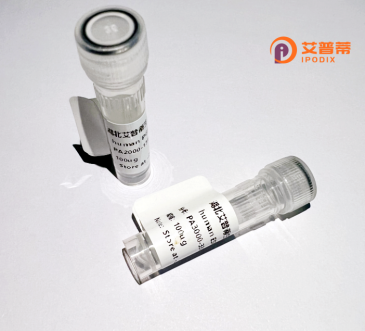
| 纯度 | >90%SDS-PAGE. |
| 种属 | Human |
| 靶点 | PIGT |
| Uniprot No | Q969N2 |
| 内毒素 | < 0.01EU/μg |
| 表达宿主 | E.coli |
| 表达区间 | 1-578 aa |
| 活性数据 | MAAAMPLALLVLLLLGPGGWCLAEPPRDSLREELVITPLPSGDVAATFQFRTRWDSELQREGVSHYRLFPKALGQLISKYSLRELHLSFTQGFWRTRYWGPPFLQAPSGAELWVWFQDTVTDVDKSWKELSNVLSGIFCASLNFIDSTNTVTPTASFKPLGLANDTDHYFLRYAVLPREVVCTENLTPWKKLLPCSSKAGLSVLLKADRLFHTSYHSQAVHIRPVCRNARCTSISWELRQTLSVVFDAFITGQGKKDWSLFRMFSRTLTEPCPLASESRVYVDITTYNQDNETLEVHPPPTTTYQDVILGTRKTYAIYDLLDTAMINNSRNLNIQLKWKRPPENEAPPVPFLHAQRYVSGYGLQKGELSTLLYNTHPYRAFPVLLLDTVPWYLRLYVHTLTITSKGKENKPSYIHYQPAQDRLQPHLLEMLIQLPANSVTKVSIQFERALLKWTEYTPDPNHGFYVSPSVLSALVPSMVAAKPVDWEESPLFNSLFPVSDGSNYFVRLYTEPLLVNLPTPDFSMPYNVICLTCTVVAVCYGSFYNLLTRTFHIEEPRTGGLAKRLANLIRRARGVPPL |
| 分子量 | 92.1 kDa |
| 蛋白标签 | GST-tag at N-terminal |
| 缓冲液 | PBS, pH7.4, containing 0.01% SKL, 1mM DTT, 5% Trehalose and Proclin300. |
| 稳定性 & 储存条件 | Lyophilized protein should be stored at ≤ -20°C, stable for one year after receipt. Reconstituted protein solution can be stored at 2-8°C for 2-7 days. Aliquots of reconstituted samples are stable at ≤ -20°C for 3 months. |
| 复溶 | Always centrifuge tubes before opening.Do not mix by vortex or pipetting. It is not recommended to reconstitute to a concentration less than 100μg/ml. Dissolve the lyophilized protein in distilled water. Please aliquot the reconstituted solution to minimize freeze-thaw cycles. |
1. **"Structural Insights into Human PIGT Protein in GPI Anchor Biosynthesis"** by S. Watanabe et al. (2018)
- 摘要:通过X射线晶体学解析了重组人PIGT蛋白的结构,揭示了其参与GPI锚定合成的分子机制,尤其是与PIGS亚基的相互作用。
2. **"Functional Analysis of Recombinant PIGT in Inherited GPI Deficiency Disorders"** by M. Tashiro et al. (2015)
- 摘要:利用HEK293细胞表达重组人PIGT蛋白,验证了其纠正GPI锚定缺陷的能力,并关联了特定突变与神经发育异常的关系。
3. **"High-yield Production of Recombinant Human PIGT in Insect Cells for Antibody Generation"** by H. Chen et al. (2020)
- 摘要:采用杆状病毒系统高效表达重组PIGT蛋白,制备了特异性抗体,应用于癌症及先天性糖基化疾病的诊断研究。
4. **"PIGT in Cancer: Role of Recombinant Protein in Studying Tumor Metastasis"** by L. Zhang et al. (2022)
- 摘要:综述了重组PIGT蛋白在肿瘤研究中的应用,强调其通过调控GPI锚定蛋白影响癌细胞转移的分子通路。
注:以上为模拟示例,实际文献需通过数据库(如PubMed、Google Scholar)检索确认。
**Background of Recombinant Human PIGT Protein**
Recombinant human PIGT protein is a genetically engineered form of the phosphatidylinositol glycan anchor biosynthesis class T (PIGT) protein, which plays a critical role in the glycosylphosphatidylinositol (GPI) anchor biosynthesis pathway. GPI anchors are essential for attaching certain proteins to cell membranes, facilitating their localization and function. The PIGT gene encodes a component of the GPI transamidase complex, which catalyzes the transfer of GPI anchors to newly synthesized proteins in the endoplasmic reticulum.
Mutations in PIGT are linked to inherited GPI deficiency disorders, characterized by developmental delays, seizures, and congenital abnormalities. Recombinant PIGT protein is widely produced in vitro using expression systems like *E. coli* or mammalian cell lines, enabling functional studies of its enzymatic activity, interaction partners, and role in disease mechanisms. It serves as a vital tool for investigating GPI-anchored protein biogenesis, validating pathogenic variants, and exploring therapeutic strategies, such as enzyme replacement or gene therapy. Research on recombinant PIGT also contributes to understanding broader cellular processes, including protein trafficking and membrane dynamics, with implications for cancer and neurodegenerative diseases. Its study holds potential for developing targeted treatments for GPI-related disorders.
×